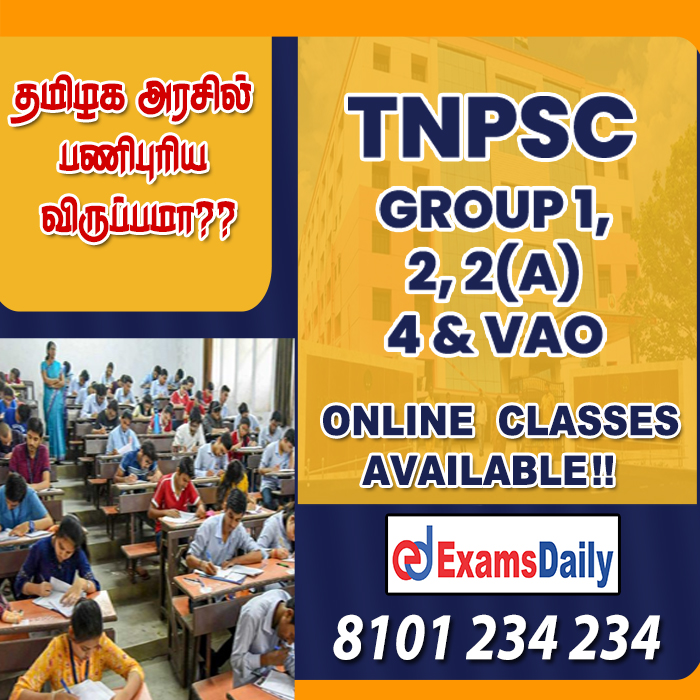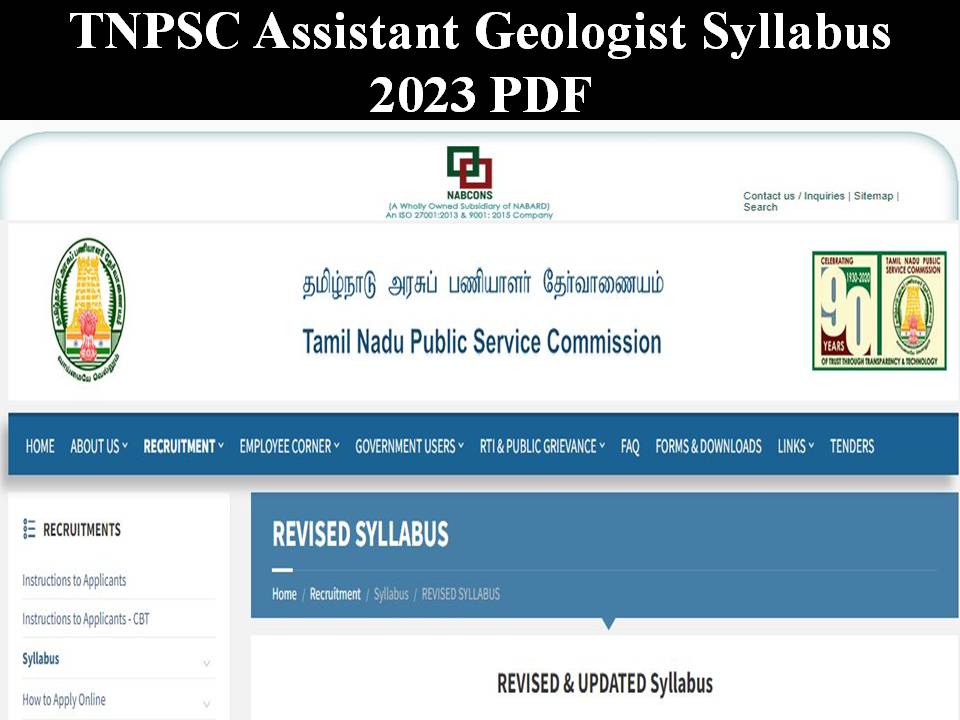TNPSC Assistant Geologist Syllabus 2023: Tamil Nadu Public Service Commission will be going to conduct the Examination for this post of Assistant Geologist in Computer Based Test (CBT) Method. The syllabus is available in this Notification and also available on the Commission’s website www.tnpsc.gov.in.
TNPSC Assistant Geologist Syllabus 2023 in Tamil
| Name of the Board | Tamil Nadu Public Service Commission |
| Post Name | Assistant Geologist |
| Vacancy | 40 |
| Exam Date | 18.08.2023 |
| Selection Process | Written Exam & Document Verification |
TNPSC Assistant Geologist Exam Date 2023:
The date of Written Examination (CBT Mode) will be held on 18.08.2023. In the case of OMR method of examination, they shall be allowed to write the examination from 2.00 P.M. to 4.00 P.M., and in the case of CBT method, they shall be allowed to write the examination from 2.30 P.M. to 4.30 P.M.
TNPSC Assistant Geologist Exam Pattern 2023:
| Subject | Duration | Maximum marks | Minimum qualifying marks for selection | |
| SCs, SC(A)s, STs, MBCs/DCs BC(OBCM)s & BCMs | Others | |||
| Paper –I:- Geology (Code No.395) (PG Degree Standard) (200 Questions) | 3 Hours | 300 | 153 | 204 |
| Paper – II:- Part-A Tamil Eligibility Test (SSLC Standard) (100 questions/150 marks) | 3 Hours | 150 Note: Minimum qualifying marks – 60 marks (40% of 150) Marks secured in Part-A of Paper-II will not be taken into account for ranking. | ||
| Part-B (General Studies)(Code No:003) (100 questions/150 marks) General Studies (Degree Standard–75 questions) and Aptitude and Mental Ability Test (SSLC Standard-25 questions)
Interview and Records |
150
60 |
|||
| Total | 510 | |||
- The questions in Paper – I will be set in English only and questions for Part B in Paper – II will be set both in English and Tamil.
- Part-A of Paper-II Tamil Eligibility Test shall contain 100 questions from 1 to 100. Part-B of Paper-II the General Studies paper contains 100 questions from 101 to 200 and time duration to write each part of the said examination shall be given 1 Hour and 30 minutes.

TNPSC Assistant Geologist Syllabus 2023:
Geology Code: 395 (Post Graduate Degree Standard)
UNIT I – GENERAL GEOLOGY AND GEOMORPHOLOGY
Origin, Evolution, Age and Interior of the Earth – Principles of geodesy – Rock cycle – Isostasy – Continental drift, Seafloor spreading, Plate tectonics – Paleomagnetism and its application for determining paleoposition of continents – Orogeny and Epeirogeny – Volcanoes and earthquakes – Effects and causes – Seismic Hazard zonation of India – Tectonic deformation and seismicity in the Extra Peninsular, Indogangetic plains and Peninsular India – Applications of geomorphology in mineral prospecting and coastal studies – Weathering – processes and products – Geomorphic cycles and their interpretation – Morphology and its relation to structures and lithology – geomorphic landforms formed by action of rivers, wind, glaciers, waves and groundwater – Features of ocean floor – continental shelf, slope and rise – concepts of landscape evolution, major geomorphic features of India – coastal, peninsular and extra peninsular – Classification of shorelines and their evolution – submarine canyons, Geosynclines and Island arcs.
UNIT-II – STRATIGRAPHY
Principles of stratigraphy – Code of stratigraphic nomenclature of India – lithostratigraphy – biostratigraphy – chronostratigraphy – magnetostratigraphy, sequence stratigraphy – Principles of stratigraphic correlation; Indian stratigraphy and economic importance – Cratons of India – Dharwar, Bastar, Singhbhum, Aravalli and Bundelkhand Cratons – Proterozoic mobile belts – Eastern Ghats Mobile Belt, Southern Granulite Terrain, Central Indian Tectonic Zone, Aravalli – Delhi Belt, North Singhbhum Mobile Belt – Proterozoic sedimentary basins – Cuddapah, Delhi, Vindhyan, Kurnool and Kaladgi – Phanerozoic stratigraphy – Paleozoic – Spiti, Kashmir and Kumaon – Mesozoic – Spiti, Kutch, Narmada Valley and Tiruchirapalli erstwhile Trichinopoly – Gondwana Supergroup, Deccan Traps – Cenozoic Assam, Bengal basins, Garhwal-Shimla Himalayas – Siwaliks – boundary problems in Indian stratigraphy Precambrian-Cambrian boundary – Permian-Triassic boundary – Cretaceous-Paleogane (K-Pg) formerly Cretaceous-Tertiary (K-T) boundary – Paleogane-Neogene and Neogene-Quaternary boundary.
UNIT III – PALEONTOLOGY
Fossil record and geological time scale – modes of preservation of fossils and concept of taphonomy – Body and ichno-fossils, species concept, organic evolution, Ediacara Fauna – morphology and time range of Graptolites, Trilobites, Brachiopods, Lamellibranchs, Gastropods, Cephalopods, Echinoids and Corals – Evolutionary trends in Trilobites, Gastropods, Cephalopods; and Graptolites – Micropaleontology – methods of preparation of microfossils, morphology of microfossil groups (Foraminifera, Ostracoda), Fossil spores and pollen – Application of micropaleontology in oil exploration – Gondwana plant fossils and their age and climate significance – Vertebrate life through ages, evolution in Proboscidea, Equidae and Hominidae – Dinosaurs – their classification and extinction – Applications of paleontological data in stratigraphy, paleoecology, and paleoclimatology – Mass Extinctions.
UNIT IV – STRUCTURAL GEOLOGY
Mechanical principles of rocks – Strain markers in deformed rocks – Mohr’s circle – V rules and outcrop patterns – Stereographic Projections of structural elements – Mechanics and causes of folding and faulting – Classification of folds and faults – Recognition of folds and faults in the field – Joints – Cleavage and Schistosity types and origin – Secondary lineation – Types of unconformity and their recognition in the field – Introduction to Petrofabric analysis – Tectonites, their classification and geological significance.
UNIT V- MINERALOGY AND CRYSTALLOGRAPHY
Definition, Classification and elements of minerals and Crystallography – Optical, Electrical and Magnetic Properties of minerals – Physical, chemical and optical properties of Quartz, Feldspars, Feldspathoids, Pyroxene, Amphibole, Olivine, Garnet, Mica, Zeolites and Carbonate groups – Stereographic and Gnomonic projections of natural crystals of normal classes. 14 Bravais lattices and their derivation – Derivation of 32 classes of symmetry – Elements of X-ray crystallography – Napier’s theorem – Equations of a normal – Bragg’s law – X-ray diffraction method – Identification of minerals from X-ray diffractogram – Concept of optical mineralogy – Identification of minerals using petrological microscope.
UNIT VI – IGNEOUS AND METAMORPHIC PETROLOGY
Classification of Igneous rocks: Mineralogical, Chemical and IUGS classification – Structures and textures – Petrography and petrogenesis of Granites, Alkaline rocks, Anorthosites, Carbonatites, Dolerites, Ultramafics – Study of binary and ternary system of crystallisation – Bowen’s reaction series – Diversity of Igneous rocks – variation diagrams – Crystallisation of Basaltic magma – Metamorphism – Agents and kinds of metamorphism.
UNIT VII – SEDIMENTOLOGY
Sedimentary depositional environments – Important clastic and nonclastic rocks – Heavy minerals and Provenance – Tectonics and Sedimentation – Sedimentary Basins of India – Paleo currents and Basin Analysis – Classification of sedimentary rocks – sedimentary textures grains size, roundness, sphericity, shape and fabric – grain size analysis – sediment transport and deposition – sedimentary structures Pen contemporaneous deformation structure and biogenic structures – principles and application of paleo current analysis – composition and significance of different types of sedimentary rocks Sandstone, Limestone, Banded Iron Formation, Mudstone and Conglomerate – carbonate diagenesis and dolomitisation – sedimentary environments and facies-facies models – fluvial, glacial, deltaic, siliciclastic shallow and deep marine environments – carbonate platforms – types and facies models; sedimentation in major tectonic settings; Application of sequence stratigraphy in basin analysis.
UNIT VIII – ECONOMIC GEOLOGY
Classification of mineral deposits – Process of formation of mineral deposits – Magmatic, Hydrothermal, Sedimentary, Metamorphic, Sublimation, Evaporation, Oxidation and Supergene enrichment – Metallogenic Epochs and provinces of India – Introduction of ore microscopy – Physical and optical properties of ore minerals – Textures and microstructures of ores – Controls of ore Localisation – Fluid inclusion in ore mineral assemblages – Origin, Occurrences, Indian distribution and uses of the following ores – Iron, Manganese, Copper, Lead, Zinc, Aluminium, Chromium, Gold, Barite, Graphite, Asbestos and Silica, Uranium, Thorium and Industrial Minerals. Origin of coal and petroleum – Physical and Chemical Properties of coal and petroleum – Deposits of coal and Petroleum in India – Distribution of Gondwana and Tertiary coal fields of India. Gas hydrates and Coal bed methane, Petroliferous basins of India – Lignite deposits in India – Strategic, Critical and essential minerals – National mineral policy 2019 – Conservation and Utilization of mineral resources.
TNPSC Assistant Geologist Notification 2023 Out – 40 Vacancies | Apply Online Now!!!
UNIT-IX: HYDROGEOLOGY
Occurrence of groundwater – Aquifers – Major Basins and Drainage systems of Tamil Nadu – Groundwater flow – Darcy’s Law – Hydraulic conductivity and Hydrological parameters – Transmissibility, Permeability – Specific yield and retention – Hydrogeological characters of different types of rocks – Rock water interaction – Types of wells – Drilling methods and methods of construction, Design and development and Well logging methods – Pumping test methods – Estimates of groundwater potential and recharge – Managed Aquifer recharge – Rainwater Harvesting techniques and methods – Aquifer recharge methods – Seawater intrusion – Study and methods – Electrical methods of groundwater exploration – Tracer – Isotope techniques.
UNIT-X: APPLIED GEOLOGY
Geophysical methods of prospecting – Electrical, Magnetic, Gravity and Seismic – Radioactive methods – Geochemical classification of elements and anomaly – Geochemical cycle – Geochemical prospecting – Engineering properties of Rocks – Geological investigations pertaining to Dams, Reservoirs, Tunnels, Bridges and Roads – Rock sampling techniques – Ore reserve estimation and UNFC. Mining Methods: Surface and Sub surface – Coal and Alluvial – Prominent mines and mineral legislations of India – Environmental impacts (EIA) due to mining and mineral processing – Role of Geologist in mining industries. Natural Hazards – Floods, Landslides, Earthquakes and Tsunami – Causes and Mitigation. Renewable and non renewable resources. Applications of Remote sensing – GIS and GPS in Geological studies classification of metamorphic Rocks – Textures and Structures – Different grades and depth Zones – Metamorphic facies – Metamorphic differentiation – Thermal – Clastic and Regional Metamorphism – Origin of Eclogites – Charnockitisation – Granitisation – Metasomatism.
PAPER – II – Part – B GENERAL STUDIES (DEGREE STANDARD) OBJECTIVE TYPE:
UNIT-I: GENERAL SCIENCE
- Scientific Knowledge and Scientific Temper – Power of Reasoning – Rote Learning vs Conceptual Learning – Science as a tool to understand the past, present and future.
- Nature of Universe – General Scientific Laws – Mechanics – Properties of Matter, Force, Motion and Energy – Everyday application of the Basic Principles of Mechanics, Electricity and Magnetism, Light, Sound, Heat, Nuclear Physics, Laser, Electronics and Communications.
- Elements and Compounds, Acids, Bases, Salts, Petroleum Products, Fertilisers, Pesticides.
- Environment and Ecology.
UNIT-II: CURRENT EVENTS:
- History – Latest diary of events – National symbols – Profile of States – Eminent personalities and places in news – Sports – Books and authors.
- Polity – Political parties and political system in India – Public awareness and General administration – Welfare oriented Government schemes and their utility, Problems in Public Delivery Systems.
- Geography – Geographical landmarks
- Economics – Current socio – economic issues.
- Science – Latest inventions in Science and Technology.
- Prominent Personalities in various spheres – Arts, Science, Literature and Philosophy.
UNIT-III: GEOGRAPHY OF INDIA:
- Location – Physical features – Monsoon, Rainfall, Weather and Climate – Water Resources – Rivers in India – Soil, Minerals and Natural Resources – Forest and Wildlife – Agricultural pattern.
- Transport – Communication.
- Social Geography – Population density and distribution – Racial, Linguistic Groups and Major Tribes.
- Natural calamity – Disaster Management – Environmental pollution: Reasons and preventive measures – Climate change – Green energy.
UNIT–IV: HISTORY AND CULTURE OF INDIA
- Indus Valley Civilization – Guptas, Delhi Sultans, Mughals and Marathas – Age of Vijayanagaram and Bahmani Kingdoms – South Indian History.
- Change and Continuity in the Socio-Cultural History of India.
- Characteristics of Indian Culture, Unity in Diversity – Race, Language, Custom.
- India as a Secular State, Social Harmony.
Download TNPSC Assistant Geologist Syllabus 2023
**Telegram Group for Latest Job Updates – Join Now**
Selection will be based on Written Examination and Document Verification.
The date of Written Examination (CBT Mode) will be held on 18.08.2023.
Candidates can download TNPSC Assistant Geologist Syllabus from our website.

